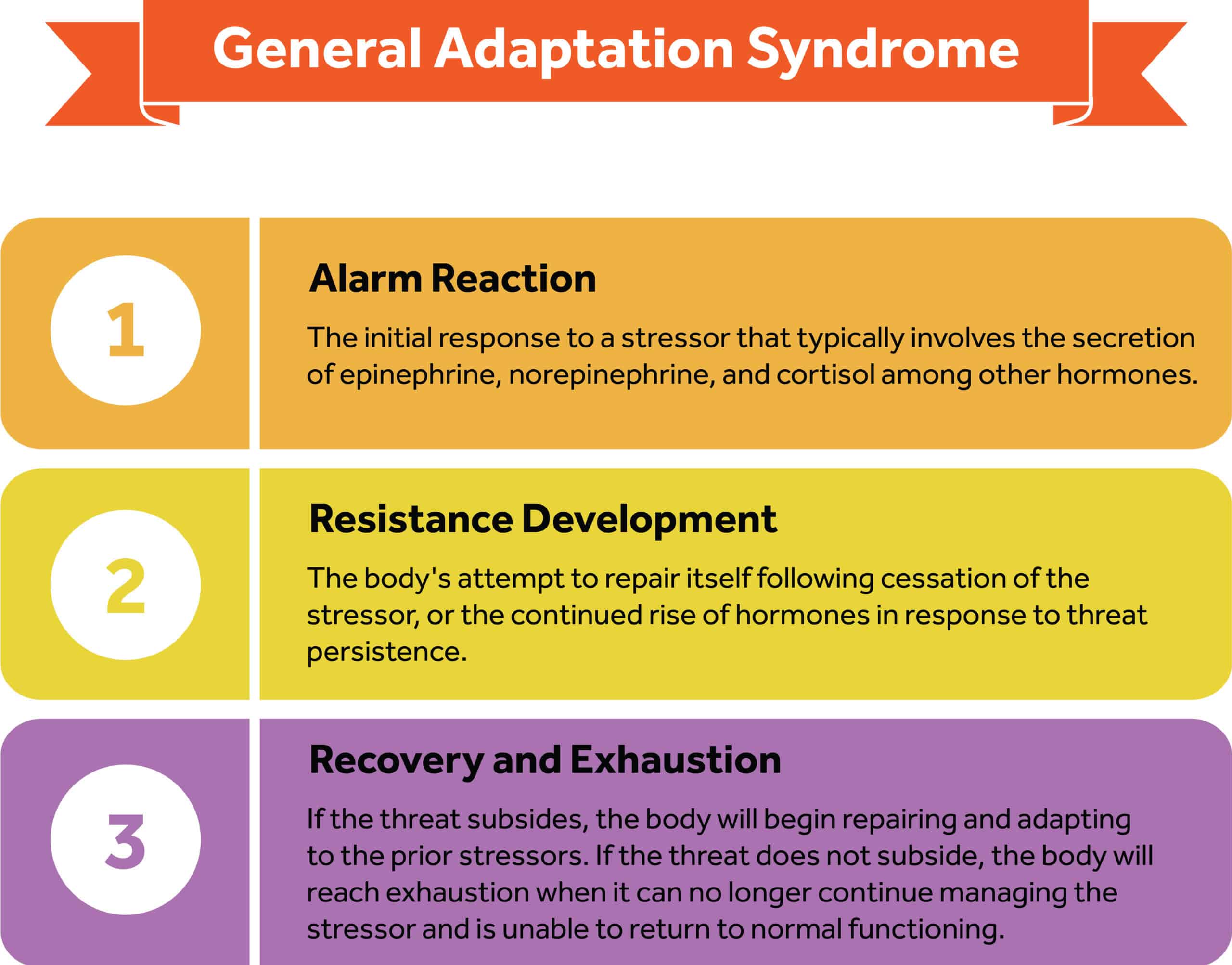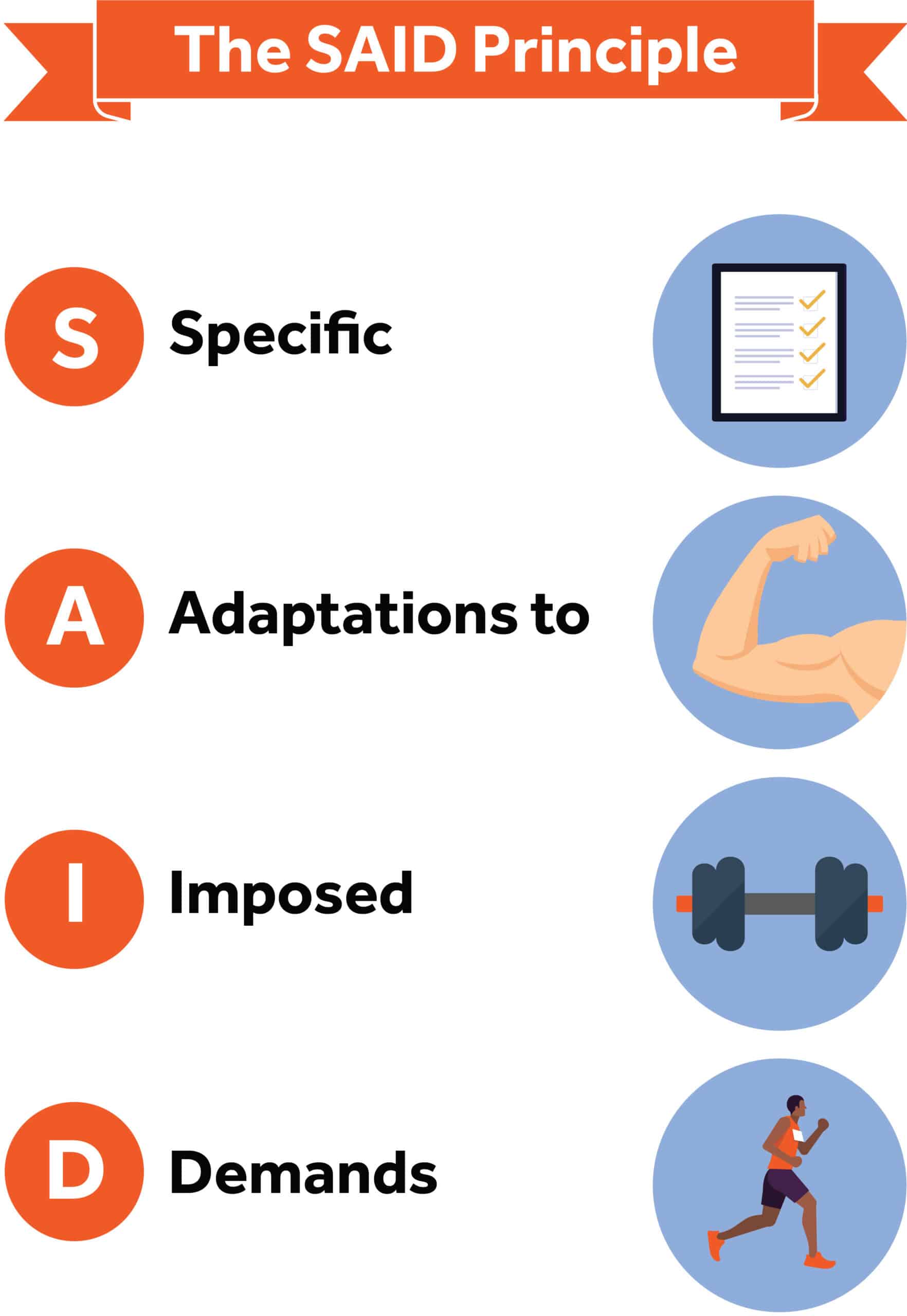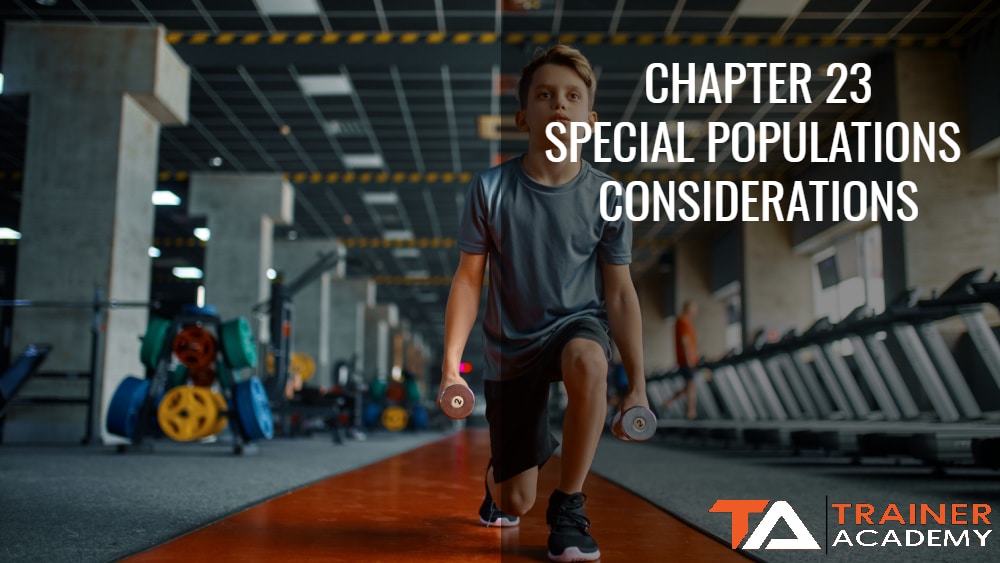The body undergoes many different beneficial adaptations in response to prolonged resistance exercise training. For general fitness clients, these adaptations are typically the primary reason for including resistance training as a pillar of fitness.
Fitness professionals must understand the various adaptations and processes to effectively plan, program, and adjust programs, as well as explain the rationale to clients.
Introduction to Adaptations to Resistance Training
Fatigue and stress on the human body causes adaptations, both positive and negative. Theory of adaptation is explained below through various methods, including General Adaptation Syndrome (GAS), the Specific Adaptations to Imposed Demands Principle (SAID), as well as the specific adaptations created through different types of training and the need to manage stimulus to fatigue in regards to recovery.
General Adaptation Syndrome
General Adaptation Syndrome is a theory developed by Dr. Hans Selye in the early-to-mid 20th century. Selye is known to be the first researcher to use the term “stress” in reference to changes in the body after a stimulus is applied.1 Stress is defined as a “non-specific response of the body to any demand.”
Through various experiments, Selye concluded that his newly coined term of General Adaptation Syndrome is “a generalized effort of the organism to adapt itself to new conditions.”
In 1950, Selye publicly adopted the position that “stress is the interaction between damage and defense. It is the rate of wear and tear caused by life.” The term stressor was coined soon after, which refers to anything that can produce both stress and specific action.
As knowledge of stress and physiological adaptations continued to develop, so did the understanding of GAS. It was repeatedly shown that regardless of the stressor being applied, the physiological processes appeared to follow a similar pattern.
The GAS was later defined in three separate stages:
- Alarm Reaction
- Resistance Development
- Exhaustion
The alarm phase was the initial response to the shock that occurred to the body which elicited a resistance, or series of metabolic defenses against the initial stimuli. If the stimuli persisted, exhaustion would occur which would lead to death in extreme cases.
Note: original studies tunneled towards physical stressors such as pain or discomfort. It is now known that emotional stressors may trigger similar physiological responses. Stressors may include a job loss, break up, financial struggles, poor grades, or embarrassment. It does not require extreme temperatures or surgeries to trigger GAS. Selye was adamant that irrespective of the nature or quantity of the stressor, the physiological mechanism of response for any living organism always remained the same.2

Alarm Reaction
The Alarm Reaction (AR) is the first stage of GAS when an organism faces a stressor. Selye compared it similar to the fight or flight reaction, but the AR allowed for chronic responses leading towards further responses.
Biological reactions during alarm reaction typically include secretion through the adrenal glands (specifically the adrenal medulla), most commonly are epinephrine and norepinephrine, however, cortisol is upregulated by the presence of epinephrine.
Other hormones affected include estrogen, testosterone, dopamine and serotonin.3
Cortisol is known as the “stress hormone.” It is present in high concentrations when the body undergoes stressful situations. When cortisol is upregulated, the response includes an increase of blood pressure, blood glucose, and the immune system is suppressed.4
Epinephrine and norepinephrine are responsible for acceleration of heart and lung activity, inhibition of digestion, constriction of many blood vessels to organs, release of lipids and glucose for energy use, dilation of muscular vessels, dilation of pupils, hearing loss, tunnel vision and shaking, for an inconclusive list.5
Remember, the primary intent behind these hormones is to survive when faced with imminent danger, therefore bodily functions that are unnecessary for short term survival (such as digestion, urination and reproduction) are inhibited until the threat is gone.
Resistance Development
Resistance Development (RD) is the second stage of Selye’s GAS model. This stage is noted by the body’s attempt to repair itself after being shocked with an influx of stress through the AR phase. There are two paths the body can take in this stage and it depends on the environment of the individual.
In the first option, hormone concentrations return to homeostatic levels if the threat has subsided. If the threat persists then the stress hormones will continue to rise, thus increasing the effects of those hormones. This means digestion continues to slow, vessels to organs continue to contract, vessels to muscles stay dilated, and heart rate and blood pressure stay elevated.
Recovery and Exhaustion
Similar to resistance development, the third and final stage may be split depending on if the threat is prominent or not. If the threat is not prominent, then recovery begins. If it is still prominent, by stage three the organism will be reaching exhaustion.
Recovery will begin when the source of stress has subsided, but the previous stages have already prepared the body to recover. The changes in hormone status from the previous two stages have upregulated the amount of glucose, lipids, and amino acids that are free floating within the bloodstream which provide a more readily available source of nutrients. Since the body is reducing stress levels, the free-floating nutrients may be utilized for recovery and anabolic reactions.7
Exhaustion can be observed when a body has worked itself until it cannot continue further. This is when energy stores are reaching near depletion of their usable stores. The body is demonstrating the inability to return to a status of normal functioning.
Personal trainers and fitness professionals must be aware of the overall implication of the General Adaptation Syndrome. Clients must understand the importance of taking days off to actually see progress. Coaches must understand how to program the proper amount of exercise to elicit the body adaptations without pushing the client past the point of exhaustion in the General Adaptation Syndrome.
Stimulus-Fatigue-Recovery-Adaptation Theory
The Stimulus-fatigue-recovery-adaptation theory suggests that exercise triggers both fatigue and adaptation. The magnitude of both depends upon the magnitude of the stimulus. Therefore, the longer or more intense the training session, the greater amount of recovery time is needed until full recovery. As the client recovers and adapts to the previous training stimulus, the more fatigue will dissipate. If the client waits too long to train again, the body will begins to detrain and it loses the adaptations. With proper programming, full recovery usually occurs before detraining begins. Then, clients can train continuously with full or near full recovery in between training stimuli for extended periods of time. This is especially true for novel exercisers, as their total workloads during sessions are typically low.
Fitness-Fatigue Paradigm
Another way to consider the interaction between stimulus and fatigue is the fitness-fatigue paradigm. If training induces both adaptation (fitness) and fatigue, then the sum of the two can be considered the primary driver of a client’s performance referred to as “preparedness.6″ When training loads are high, fitness rises; however, so does fatigue. Therefore, preparedness is relatively low. This is also true if training loads are very low. Fitness is low, but so is fatigue. Thus, a balance must be struck, via a structured periodized program, which will dissipate fatigue but maintain a high level of fitness.
Accumulation vs Deloading vs Maintenance
Accumulation, deloading, and maintenance are the programmatic applications of GAS and the other physiological theories behind periodized training.
Accumulation
Periods of hard training, wherein adaptations are stimulated, and fatigue is accrued is referred to as accumulation. The number of these sessions that an individual can perform continuously (i.e. the weeks of hard training) without a period of recovery will vary based on a variety of factors such as training age (experience with exercise), chronological age, dietary status, sleep quality, stress levels, and training intensity. However, even under optimal conditions, all clients eventually reach a point where training stagnates. This is the time to deload.
Deloading
A deload is a period of reduced training volume and intensity to allow the body to recover and for the adaptative mechanisms to resensitize the body to training. Deloads typically last one week but must vary based on clients’ needs.
Programming a deload can often be challenging for trainers, especially when working with new clients. There are two variables to consider: the length of deload and the degree to which normal training volume and intensity are reduced.
Length of Deload
A week has become a standard deload period for many exercisers across a broad spectrum of training and chronological age. This allows for mental recovery, as well as physiological recovery of the muscle tissues and joints. However, shorter periods can be employed for clients with limited training experience, as their exercise-induced muscle damage is lower than intermediate or advanced clients. Also, older clients may require longer deload periods as their recovery cycle is often longer. Research is still underway to quantify the optimal range of deload duration, however anecdotal evidence suggests that no fewer than 3 days and no longer than 2 weeks are best.
Volume and Intensity Reduction
The second variable of the deload: training volume and intensity, has greater variation. The goal of the deload is to reduce training stress; this can be accomplished by reducing the load or volume of training, or both. A common strategy is to maintain the training load and reduce the volume by half. However, if joint stress is an issue, consider reducing the load by half or one third should also be considered.3 In either case, as long as the goal (reducing training stress) is met, any strategy can be effective. On the other hand, a week of complete rest, with no training, is not recommended. It is well established by research that mild amounts of physical activity actually facilitate recovery; therefore, some level of training is better than none.
Maintenance
Even with regular deloading periods at the end of mesocycles, occasional periods of prolonged active recovery, called maintenance cycles, are suggested. Months of prolonged training, even properly programmed with deloads, lead to significant wear and tear on the joints and substantial loss of psychological arousal for training. Maintenance cycles can solve these problems before manifest. During maintenance clients should train very little, only enough to maintain their current level of fitness. The focus during this 3—4 week cycle is twofold: mental and physical recovery. Clients should continue to be physically active and engaging in daily mobility and warm-up activities. Clients can also engage in several one to two training sessions per week but intensity and volume should be very low.
The relationship between accumulation, deload, and maintenance is cyclical. Clients should engage in prolonged periods of accumulation, concluding with deloads as needed. When deloads are no longer effective at reducing fatigue or when overuse injuries begin to occur, a maintenance phase is necessary.
SAID Principle
The SAID acronym stands for Specific Adaptations to Imposed Demands and applies the concepts of the General Adaptation Syndrome to reach a given goal.
For a simple example, if an individual is trying to run a marathon, most of their training will likely be surrounded by endurance-based activities.
A client who is training to complete a marathon will not benefit from max effort bench press training during their preparation, because the adaptation for a heavy bench press does not improve lower body endurance.
However, a competitive powerlifter who is preparing for a competition would utilize a heavy bench press during their training since the one-repetition max bench press is relevant to their sport.
The powerlifter will likely not be running in a way that raises aerobic capacity, as a strategy to prepare for a bench press contest. The concept of imposing demands similar to that of the goal that the individual is trying to achieve is utilizing the SAID Principle.

Progressive Adaptations to Resistance Training
During the training process, there are two ways to induce an adaptation. One is to increase the training load (intensity, volume), while continuing to employ the same drill, for example, endurance running, where the length of the run increases.
The other is to change the drill, provided that the exercise is new, and the athlete is not accustomed to it. If an athlete uses a standard exercise with the same training load over a very long time, there will be no additional adaptations and the level of physical fitness will not substantially change.”12
When this concept is applied to resistance training, the amount of weight being lifted needs to be greater than the normal amount that the person would normally lift, if they want to continuously see progress. The weight lifted could increase through more total repetitions (between all sets and repetitions), or through an absolute load (90lbs instead of 80lbs).
If the athlete continues with the same volume scheme each time they perform the exercise, such as 3x10x80lbs every week on the exact same movement, they will eventually stop progressing and become stagnant. Variables that can be changed include the weights, repetitions, sets, rest periods, frequency, and total volume. Additionally, using different variations of movements or types of exercises is another way to change the stimulus and promote further adaptations.
Skeletal muscle adaptations are achieved through training programs, with the intent to achieve a specific goal. In the context of resistance training, the main adaptations are muscular endurance, hypertrophy, strength, and power.
While each of these adaptations has crossover in terms of their effects and benefits, they each represent distinct changes in the muscle fibers that must be specifically targeted with appropriate workout programming depending on the client’s goal.
Muscular Endurance
Athletes who specialize in muscular endurance largely participate in exercises that contain a relatively light-to-moderate resistance, but do not greatly activate the cardiorespiratory system.
Muscular endurance exercises can be split between maximum repetitions within a set time, such as 60-second max repetition push up drills, or they can involve a max time that a person can maintain a specific posture or pace of repetitions, such as in a two-minute plank.
Remember that absolute strength is not the goal and it’s been shown that when using weight below 25% of a one-repetition max effort attempt, it is impossible to predict the number of repetitions an athlete could complete.
Strength and endurance are not closely related. Athletes who train with an endurance intent will typically work within the 12-25 repetition range, or even a greater number. These athletes should keep short rest periods in an attempt to increase their rate of lactate buffering.
Maintaining rest intervals between 30-60 seconds, or approximately a 1:1 ratio of work to rest, will create an environment that increases blood lactate levels. Clients training under this condition will more efficient at buffering blood lactate so the individual has an increased ability to sustain repeated moderate to maximal muscle contractions over a longer period of time.13
Hypertrophy
Hypertrophy at its root is an increase in the size of the muscle cells, resulting in an increase in muscle cross-section area and volume.
For most general fitness clients, especially those who are deconditioned, improved muscle mass is generally a beneficial adaptation in terms of health outcomes and obtaining a more muscular appearance.
During resistance training, mechanical and metabolic stress results in muscle damage and the subsequent hormonal responses that stimulate hypertrophy.
Hypertrophy generally occurs due to an increase in the size of existing muscle fibers via the addition of myofibrils and increases in actin and myosin and other muscle cell components. The hormones secreted in response to resistance training play a major role in driving muscular hypertrophy.
Clients who seek to maximize muscle hypertrophy should use weights equivalent to a 5-12 repetition maximum effort attempt. Clients should perform multiple sets while leaving 1-2 repetitions in reserve and resting between 1-2 minutes to maximize hypertrophy.12
Strength
In the context of fitness training, strength is the ability of the body to exert force via muscular contraction. The purest measure of absolute strength on a given movement or exercise is the 1-repetition maximum. Resistance training activities for improvements in strength typically utilize a lower number of repetitions, often between 1 to 5, high levels of resistance, and longer rest periods.
When individuals train towards the goal of maximal strength, adaptations occur within the body to accommodate for the increased stimuli and demands being placed. These adaptations change the body and increase its ability to exert force, translating into greater performance on maximal strength activities, as well as the associated beneficial biological adaptations.
Changes within the body that contribute to an increase in strength have to do with both the physical side of the body and the neural side of the body such as motor recruitment, covered in the nervous system chapter.
While strength adaptations do not occur solely as a result of hypertrophy, increased muscle cross-section results in greater force production capabilities.
When discussing the physical adaptations of hypertrophy, the most noticeable is the increase in cross-sectional area (CSA) of the muscle fibers and an increase in sarcomere volume.14
As discussed in the skeletal system chapter, bone mineral density, and subsequent bone mass increase as a progressive response to resistance training. This increases the ability of the skeletal system to withstand external resistance and resist bone fractures.16
Tendons are another site of adaptation to resistance training. Researchers have found that just 12 weeks of resistance training improved tendon stiffness, reflecting greater tendon strength.17
In the long run, increased strength depends on increasing the size of the muscle fibers, the ability of the nervous system to fully recruit fibers, and the density and strength of the skeletal system. For this reason, strength-focused periodization plans usually include hypertrophy-focused training blocks as well as higher intensity, lower repetition strength blocks to drive neural adaptations.
Similarly, general fitness clients benefit from cycling between programs focused on muscular endurance, hypertrophy, and strength to elicit the full array of beneficial adaptations to resistance training. How to structure and cycle workout programs is covered in more depth in the chapter on periodization.
Power
Power in the absolute sense is a measurement of the rate of energy production of a given activity.
In the context of physical fitness adaptations, power refers to the ability to create maximal force within minimal time.12
As such, the rate of force production matters in power considerations alongside the maximum force exerted. To increase the rate of force development, which is the primary goal for power training, an individual must train in a manner that increases their ability to move faster.
Power exercises include explosive lifts such as those in Olympic weightlifting, plyometric activities such as jumping, and maximal effort sprints using traditional aerobic modalities such as running sprints, cycling, or rowing using short working periods and long rest periods to ensure sufficient effort on each set.
Most strength-focused training exercises also improve power, especially in novice athletes and the deconditioned. Since power depends on both speed of movement and the amount of resistance, increasing the resistance while maintaining the same speed of movement reflects improved power. As the client gains training experience, continued power focused adaptations will require specific focus on movement speed.
In the context of aerobic training, power is typically expressed as watts and is used as a way to measure the absolute output. Activities such as cycling make measuring watts straightforward compared to running or swimming. While this use of “power” is correct from a physics standpoint, when it comes to resistance training, power training primarily refers to anaerobic exercises performed quickly and explosively.
In the context of personal fitness training, power training can include a variety of bodyweight and equipment-based training methods. Jump squats, Olympic lifting, medicine ball throws, and any movements performed quickly and explosively are all power training exercises commonly used to elicit improvements in peak power.
The adaptations to power development are comparable to that of strength adaptations. In a study by MacDougall that was published in the Journal of Applied Physiology, they observed the physiological differences in 12 healthy men who participated in a sprint style program on a cycle ergometer.20 It is important to understand that these are not elite athletes.
These 12 healthy men trained with multiple bouts of 30-second sprints for 7 weeks. On week 1 the subjects began with 3 sessions per week and performed 3 – 30 second sprints on week 1 and increased to 10 – 30 second sprints during week 7. Between each bout was a 4 minute rest period for the first 4 weeks. In weeks 5-7, they decreased their rest periods by 30s each week.
Significant results from the study showed an increase in 12% mean total power output after the 4th bout of sprints and approximately a 25% increase in peak power output among the participants when comparing their 7-week differences. They demonstrated a 7% increase in VO2 max, a 49% increase in phosphocreatine kinase (PFK) activity, 56% increase in hexokinase activity and 36% increase in citrate synthase (CS) activity.
Overall, this demonstrates that clients can experience significant beneficial results from a variety of strength and power training modalities.
Fitness professionals should take note that adaptations to resistance training occur primarily on a spectrum where certain adaptations are more heavily favored within certain repetition, intensity, and movement speed ranges as opposed to a hard cutoff point for each adaptation.
For example, training with 3-5 repetitions using appropriate intensity will result in some hypertrophy alongside the strength adaptation. Hypertrophy would be increased between 8-12 repetitions, while still eliciting some strength gains. Finally, pushing past the 12 repetition range will cause an increasing shift away from hypertrophy and towards muscular endurance.
Sedentary, deconditioned clients will see the greatest across-the-board adaptations using a variety of repetition ranges. As training experience increases, training programs must be specific to the desired adaptations to ensure progress.
Summary
Taking into account the adaptations caused by different stressors on the body, fitness professionals should be monitoring the system fatigue in clients throughout a training cycle, as well as choosing specific exercises to target the changes clients are looking for through an exercise program. Hypertrophy, endurance, strength, and power all require different loads, rep ranges, rest periods, and exercises, while blocks of accumulation, deloading, and maintenance may be required to achieve optimal results based on overall recoverability across a training cycle.
References
- Jackson M. Evaluating the Role of Hans Selye in the Modern History of Stress. In: Cantor D, Ramsden E, editors. Stress, Shock, and Adaptation in the Twentieth Century. Rochester (NY): University of Rochester Press; 2014 Feb. Chapter 1. Available from: https://www.ncbi.nlm.nih.gov/books/NBK349158/
- Paul, M. (2020, July 24). The Scientific Legacy of Hans Selye. Nootropics Official. https://nootropicsofficial.com/the-scientific-legacy-of-hans-selye
- Walter Bradford Cannon (1915). Bodily Changes in Pain, Hunger, Fear and Rage: An Account of Recent Researches into the Function of Emotional Excitement.
- Padgett, David; Glaser, R (August 2003). “How stress influences the immune response”. Trends in Immunology. 24 (8): 444–448.
- Henry Gleitman, Alan J. Fridlund and Daniel Reisberg (2004). Psychology (6 ed.). W. W. Norton & Company.
- WebMD. (n.d.). Ammonia Aromatic Inhalation: Uses, Side Effects, Interactions, Pictures, Warnings & Dosing. WebMD. https://www.webmd.com/drugs/2/drug-7536/ammonia-aromatic-inhalation/details
- Gozhenko, AI; Gurkalova, IP; Zukow, W; Kwasnik, Z; Mroczkowska, B (2009). Gozhenko, AI; Zukow, W; Kwasnik, Z (eds.). Pathology: Medical student’s library. Radom University. p. 272
- Adamsson A, Bernhardsson S. Symptoms that may be stress-related and lead to exhaustion disorder: a retrospective medical chart review in Swedish primary care. BMC Fam Pract. 2018 Oct 30;19(1):172. https://doi.org/10.1186/s12875-018-0858-7. PMID: 30376811; PMCID: PMC6208049.
- Schmidt, R.A. (1988). Motor Control and Learning: A Behavioral Emphasis. 2nd ed. Champaign, IL: Human Kinetics.
- Thompson, D. (2001, November 26). Motor teaching and motor learning. Oklahoma University of Health Science. https://ouhsc.edu/bserdac/dthompso/web/mtrlrng/mtrlrng.htm
- Human Kinetics. (n.d.). Vladimir M. Zatsiorsky. Human Kinetics. Retrieved July 27, 2022, from https://www.human-kinetics.co.uk/author/vladimir-m-zatsiorsky/
- Zatsiorsky, V., & Kraemer, W. (2006). Science and Practice of Strength Training (2nd ed.).
- Parsons, D. (2019, January 4). Rest Periods Between Sets. ISSA. https://www.issaonline.com/blog/post/rest-periods-between-sets–everything-you-ever-needed-to-know-
- Hughes DC, Ellefsen S, Baar K. Adaptations to Endurance and Strength Training. Cold Spring Harb Perspect Med. 2018 Jun 1;8(6):a029769. https://doi.org/10.1101/cshperspect.a029769. PMID: 28490537; PMCID: PMC5983157.
- Maughan, R J, Watson, J S, Weir, J, (1983), Strength and cross-sectional area of human skeletal muscle. The Journal of Physiology, 338. https://doi.org/10.1113/jphysiol.1983.sp014658.
- Anna-Lena Zitzmann, Mahdieh Shojaa, Wolfgang Kemmler, The effect of different training frequency on bone mineral density in older adults. A comparative systematic review and meta-analysis, Bone, Volume 154, 2022, 116230, ISSN 8756-3282, https://doi.org/10.1016/j.bone.2021.116230.
- Bohm, S., Mersmann, F. & Arampatzis, A. Human tendon adaptation in response to mechanical loading: a systematic review and meta-analysis of exercise intervention studies on healthy adults. Sports Med – Open 1, 7 (2015). https://doi.org/10.1186/s40798-015-0009-9
- Alvidrez, L., & Kravitz, L. (n.d.). Hormones Responses Resistance Training. The University of New Mexico. https://www.unm.edu/~lkravitz/Article%20folder/hormoneResUNM.html
- Vingren JL, Kraemer WJ, Ratamess NA, Anderson JM, Volek JS, Maresh CM. Testosterone physiology in resistance exercise and training: the up-stream regulatory elements. Sports Med. 2010 Dec 1;40(12):1037-53. https://doi.org/10.2165/11536910-000000000-00000. PMID: 21058750.
- Muscle performance and enzymatic adaptations to sprint interval training J. Duncan MacDougall, Audrey L. Hicks, Jay R. MacDonald, Robert S. McKelvie, Howard J. Green, and Kelly M. Smith Journal of Applied Physiology 1998 84:6, 2138-2142
- Barker, D. (2020, October 13). Understanding Reciprocal Inhibition. San Diego Personal Training. https://sandiegopersonaltraining.com/2020/10/13/understanding-reciprocal-inhibition/
- US Army Public Health Center. (2020). Strength Tests in Army Fitness Training and Assessment of a Pilot Program. Tip No. 12-119-0121.
- U.S. Army. (2012). FM 7-22; Army Physical Readiness Training. Department of the Army.
- Paul, A. C., & Rosenthal, N. (2002). Different modes of hypertrophy in skeletal muscle fibers. The Journal of Cell Biology, 156(4), 751-760. https://doi.org/10.1083/jcb.200105147












